1928 Summer Olympics
|
Logo of the 1928 Summer Olympics | |||
| Host city | Amsterdam, Netherlands | ||
|---|---|---|---|
| Nations participating | 46 | ||
| Athletes participating | 2,883 (2,606 men, 277 women) | ||
| Events | 109 in 14 sports | ||
| Opening ceremony | July 28 | ||
| Closing ceremony | August 12 | ||
| Officially opened by | Prince Hendrik | ||
| Athlete's Oath | Harry Dénis | ||
| Olympic Torch | None | ||
| Stadium | Olympisch Stadion | ||
| Summer: | |||
| |||
| Winter: | |||
| |||
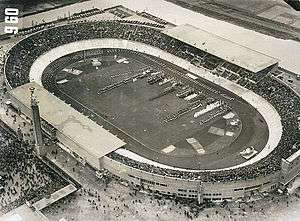
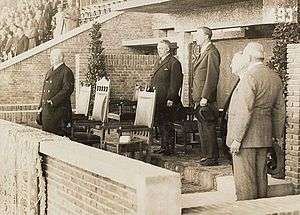
The 1928 Summer Olympics (Dutch: Olympische Zomerspelen 1928), officially known as the Games of the IX Olympiad, was an international multi-sport event which was celebrated in 1928 in Amsterdam, Netherlands. Amsterdam had bid for the 1920 and 1924 Olympic Games, but had to give way to wartorn Antwerp, Belgium, and Pierre de Coubertin's Paris, respectively. The only other candidate city for the 1928 Games was Los Angeles, which would host the Olympics four years later.
The United States Olympic Committee measured the costs and revenue of the 1928 Games in preparation for the 1932 Summer Olympics. The committee reported a total cost of US$1.183 million with receipts of US$1.165 million for a loss of US$18,000—much less than that of the previous Games.[1]
Highlights

- These Olympics were the first to be organised under the IOC presidency of Henri de Baillet-Latour
- For the first time, the Olympic Flame was lit during the Olympics.[2] The torch relay, however, would not occur until the 1936 Summer Olympics.
- For the first time, the parade of nations started with Greece, which holds the origins of the Olympics, and ended with the host country, a tradition which continues today.
- The Games were officially opened by Prince Hendrik, consort of Queen Wilhelmina, who had authorized him to deputise for her. This was the second time a head of state had not personally officiated at an Olympic opening ceremony. The first at the games of 1904 in St. Louis, Missouri, by David R. Francis the mayor of St. Louis. In opposition he had refused offers by heads of state to do this, whereas the Queen refused as she was on holiday in Norway and did not want to disrupt her trip. The Queen was furious at the organizing committee for not consulting with her about the opening date.
- Athletics events were held on a 400-meter track, later becoming the standard for athletics tracks.
- These games were the first to feature a standard schedule of 16 days, which is still followed. Previously, competition had been stretched out over several months.
- Johnny Weissmuller, who later appeared in several Tarzan movies, won two gold medals in swimming.
- Paavo Nurmi of Finland won his ninth and final gold medal in the 10,000 m race.
- Canada's Percy Williams surprised everyone by winning both the 100 m and 200 m sprint events.
- South American football made a definite breakthrough, as Uruguay retained its title by defeating Argentina.
- India took its first ever gold in the sport of field hockey, beginning a streak of six consecutive gold medals in the sport.
- Mikio Oda of Japan won the triple jump event with a result of 15.21 meters (49 ft 11 in), becoming the first gold medalist from an Asian country.
- The then Crown Prince Olav, later King of Norway, was amongst the participants. He won a gold medal in sailing.
- Pat O'Callaghan won newly independent Ireland's first ever medal, taking gold in the hammer throw.
- The first appearance of the sponsor Coca-Cola at the Olympic Games.
- These games were the first to bear the name "Summer Olympic Games".
- Germany returned to the Olympic Games for the first time since 1912, after being banned from the 1920 and 1924 Games. The German team finished second in the 1928 medal count.
- Many cars were expected for the Games, but Amsterdam didn't have single parking places larger than for 2,000 cars. So for (foreign) visitors a symbol was launched where they could park their car. As it was described in the Sumatra Post on 4 May 1928: a round blue sign with a white P. It would become the international traffic sign for parking.[3]
Host city selection
Frederik van Tuyll van Serooskerken first proposed Amsterdam as host city for the Summer Olympic Games in 1912, even before the Netherlands Olympic Committee was established. In 1916 the Olympic Games were cancelled due to World War I. In 1919 the Netherlands Olympic Committee abandoned the proposal of Amsterdam in favour of their support of the nomination of Antwerp as host city for the 1920 Summer Olympics. In 1921 Paris was selected for the 1924 Summer Olympics on the condition that the 1928 Summer Olympics would be organized in Amsterdam. This decision, supported by the Netherlands Olympic Committee, was announced by the International Olympic Committee on 2 June 1921. The decision was disputed by the Americans, but their request to allocate the 1928 Summer Olympics to Los Angeles was without success in 1922 and again in 1923.[4] Los Angeles was eventually selected as host city for the 1932 Summer Olympics.[5]
Sports
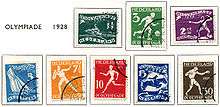
During the Summer Olympics, there were 14 sports, 20 disciplines and 109 events in the tournament. In parentheses is the number of events per discipline.[5]
- Aquatics
 Diving (4)
Diving (4)  Swimming (11)
Swimming (11)  Water polo (1)
Water polo (1)
 Athletics (27)
Athletics (27)  Boxing (8)
Boxing (8) _pictogram.svg.png) Cycling
Cycling
- Road (2)
- Track (4)
 Equestrian
Equestrian
- Dressage (2)
- Eventing (2)
- Show jumping (2)
 Fencing (7)
Fencing (7)  Football (1)
Football (1) _pictogram.svg.png) Gymnastics (8)
Gymnastics (8)  Field hockey (1)
Field hockey (1)  Modern pentathlon (1)
Modern pentathlon (1)  Rowing (7)
Rowing (7)  Sailing (3)
Sailing (3)  Weightlifting (5)
Weightlifting (5)  Wrestling
Wrestling
- Freestyle (7)
- Greco-Roman (6)
Women's athletics and team gymnastics debuted at these Olympics,[6] in spite of criticism. Halina Konopacka of Poland became the first female Olympic track and field champion. Reports that the 800 meter run ended with several of the competitors being completely exhausted were widely (and erroneously) circulated. As a result, the IOC decided that women were too frail for long distance running, and women's Olympic running events were limited to 200 meters until the 1960s.[7]
Tennis disappeared from the program, only to reappear in 1968 as a demonstration sport.
Demonstration sports
These Games also included art competitions, which the IOC no longer considers as official medal events.
Venues
Fourteen sports venues were used for the 1928 Summer Olympics. The Swim Stadium was demolished in 1929 with it being a temporary venue.[8] Het Kasteel was renovated in 1998-9. Monnikenhuize was demolished in 1950. The Schermzaal was demolished. Olympic Stadium was renovated in 2007 and is still in use. Old Stadium has since been demolished and replaced by housing in the Amsterdam area.
| Venue | Sports | Capacity | Ref. |
|---|---|---|---|
| Amersfoort | Modern pentathlon (riding) | Not listed. | [9] |
| Amsterdam | Cycling (road) | Not listed. | [10] |
| Buiten Y | Sailing | 2,263 | [11] |
| Hilversum | Equestrian (non-jumping), Modern pentathlon (running) | 4,763 | [12] |
| Krachtsportgebouw | Boxing, Weightlifting, Wrestling | 4,634 | [13] |
| Monnikenhuize (Arnhem) | Football | 7,500 | [14] |
| Old Stadion | Field hockey, Football | 29,787 | [15] |
| Olympic Sports Park Swim Stadium | Diving, Modern pentathlon (swimming), Swimming, Water polo | 6,000 | [8] |
| Olympic Stadium | Athletics, Cycling (track), Equestrian (jumping), Football, Gymnastics, Korfball | 33,025 | [16] |
| Schermzaal | Fencing, Modern pentathlon (fencing) | 559 | [17] |
| Sloterringvaart, Sloten | Rowing | 2,230 | [18] |
| Sparta Stadion Het Kasteel (Rotterdam) | Football | 11,026 | [19][20] |
| Zeeburg Shooting Grounds | Modern pentathlon (shooting) | 10,455 | [9] |
| Zuiderzee | Sailing | 2,263 | [11] |
Participating nations


A total of 46 nations were represented at the Amsterdam Games. Malta, Panama, and Rhodesia (now Zimbabwe) competed at the Olympic Games for the first time. Germany returned after having been banned in 1920 and 1924.[21]
-
 Argentina (81)
Argentina (81) -
 Australia (18)
Australia (18) -
 Austria (73)
Austria (73) -
.svg.png) Belgium (186)
Belgium (186) -
 Bulgaria (5)
Bulgaria (5) -
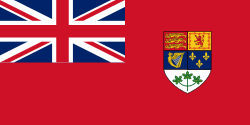 Canada (69)
Canada (69) -
 Chile (38)
Chile (38) -
 Cuba (1)
Cuba (1) -
 Czechoslovakia (70)
Czechoslovakia (70) -
 Denmark (91)
Denmark (91) -
.svg.png) Egypt (32)
Egypt (32) -
 Estonia (20)
Estonia (20) -
 Finland (69)
Finland (69) -
 France (255)
France (255) -
.svg.png) Germany (296)
Germany (296) -
 Great Britain (232)
Great Britain (232) -
.svg.png) Greece (23)
Greece (23) -
.svg.png) Haiti (2)
Haiti (2) -
 Hungary (109)
Hungary (109) -
 India (21)
India (21) -
 Ireland (27)
Ireland (27) -
.svg.png) Italy (174)
Italy (174) -
.svg.png) Japan (43)
Japan (43) -
 Latvia (14)
Latvia (14) -
.svg.png) Lithuania (12)
Lithuania (12) -
 Luxembourg (46)
Luxembourg (46) -
.svg.png) Malta (9)
Malta (9) -
.svg.png) Mexico (30)
Mexico (30) -
 Monaco (7)
Monaco (7) -
 Netherlands (264) (Host nation)
Netherlands (264) (Host nation) -
 New Zealand (10)
New Zealand (10) -
 Norway (52)
Norway (52) -
 Panama (1)
Panama (1) -
.svg.png) Philippines (4)
Philippines (4) -
.svg.png) Poland (93)
Poland (93) -
 Portugal (31)
Portugal (31) -
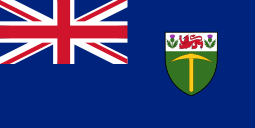 Rhodesia (2)
Rhodesia (2) -
 Romania (29)
Romania (29) -
.svg.png) South Africa (24)
South Africa (24) -
.svg.png) Spain (80)
Spain (80) -
 Sweden (100)
Sweden (100) -
 Switzerland (133)
Switzerland (133) -
 Turkey (31)
Turkey (31) -
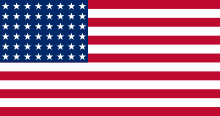 United States (280)
United States (280) -
 Uruguay (22)
Uruguay (22) -
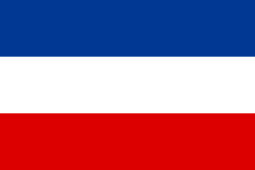 Yugoslavia (34)
Yugoslavia (34)
Medal count
These are the top ten nations that won medals at the 1928 Games.
| Rank | Nation | Gold | Silver | Bronze | Total |
|---|---|---|---|---|---|
| 1 | | 22 | 18 | 16 | 56 |
| 2 | | 10 | 7 | 14 | 31 |
| 3 | | 8 | 8 | 9 | 25 |
| 4 | | 7 | 6 | 12 | 25 |
| 5 | | 7 | 5 | 7 | 19 |
| 6 | | 7 | 4 | 4 | 15 |
| 7 | | 6 | 10 | 5 | 21 |
| 8 | | 6 | 9 | 4 | 19 |
| 9 | | 4 | 5 | 0 | 9 |
| 10 | | 4 | 4 | 7 | 15 |
Poster

The official poster for the Games was designed by Jos Rovers, and 10,000 copies were made. The poster displays a running man in a white shirt, with in the background the Olympic stadium and the Olympic flag (shown above). The IOC never succeeded in getting the copyright of the image. Therefore, out of practical considerations, the IOC has used a different poster, with the German text Olympische Spiele, and an athlete partly covered in the Dutch national flag, holding a peace leaf in his hand. This poster was made for a German book about the Amsterdam Olympics.[22]
Canon of Amsterdam
- The 1928 Summer Olympics is window number 37 in the Canon of Amsterdam.
See also
Surviving competitors
As of May 2016, there is at least one competitor of the 1928 Summer Olympics still living; Clara Marangoni, an Italian gymnast who competed in the games and won a silver medal despite still being only 12 years old. She is now 100 years old.[23]
Notes
- ↑ Zarnowski, C. Frank (Summer 1992). "A Look at Olympic Costs" (PDF). Citius, Altius, Fortius. 1 (1): 16–32. Retrieved 2007-03-24.
- ↑ "Amsterdam 1928". Olympic.org. Retrieved 2012-07-09.
- ↑
- ↑ Chicago Tribune Co. "America Bids for Games: Olympics of 1928 May be Held in This Country", New York Times. 6 April 1923. Page 15.
- 1 2 G. van Rossem (ed.) (1928). The Ninth Olympiad Amsterdam 1928 Official Report (PDF). Amsterdam: J. H. de Bussy. pp. 973–985. Archived (PDF) from the original on 8 April 2008. Retrieved 2008-03-25.
- ↑ "Timeline of Women in Sports". Faculty.elmira.edu. Retrieved 2014-02-12.
- ↑ "The Forgotten History of Female Athletes Who Organized Their Own Olympics | Bitch Media". Retrieved 2016-07-28.
- 1 2 1928 Summer Olympics official report. pp. 193, 203, 205-9, 277.
- 1 2 1928 Summer Olympics official report. p. 277.
- ↑ 1928 Summer Olympics official report. p. 264.
- 1 2 1928 Summer Olympics official report, featuring map of the Buiten IJ. pp. 271-2, 274.
- ↑ 1928 Summer Olympics official report. pp. 167, 271-8.
- ↑ 1928 Summer Olympic official report. pp. 200-1, 205.
- ↑ FIFA.com 1928 Summer Olympic CHI-MEX results.
- ↑ 1928 Summer Olympics official report. pp. 173-80.
- ↑ 1928 Summer Olympics official report. pp. 173-205.
- ↑ 1928 Summer Olympics official report. pp. 170, 202, 205.
- ↑ 1928 Summer Olympics official report. pp. 172, 267-72.
- ↑ FIFA.com 1928 Summer Olympics NED-BEL results from 5 June.
- ↑ FIFA.com 1928 Summer Olympics NED-CHI results from 8 June.
- ↑ Guttmann, Allen (1992). The Olympics: A History of the Modern Games. Urbana and Chicago: University of Illinois Press. p. 38. ISBN 0-252-01701-3.
- ↑ Henk van Gelder: De Spiele in Amsterdam, NRC Handelsblad 30 juli 1996
- ↑ Clara Marangoni's profile at Sports Reference.com
External links
| Wikimedia Commons has media related to 1928 Summer Olympics. |
- "Amsterdam 1928". Olympic.org. International Olympic Committee.
- "Results and Medalists". Olympic.org. International Olympic Committee.
- The Ninth Olympiad. Amsterdam 1928. Official Report
- "Louis S. Nixdorff Diary, July 10-August 15, 1928"
- Memorabilia of the Ninth Olympiad 1928 Amsterdam
| Preceded by Paris |
Summer Olympic Games Amsterdam IX Olympiad (1928) |
Succeeded by Los Angeles |
